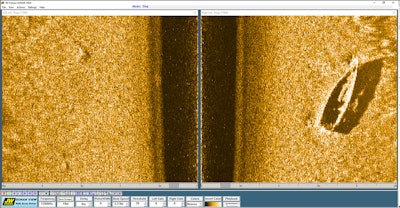 JW Fishers Side Scan Sonar image of boat under water. Photo: JW Fishers
JW Fishers Side Scan Sonar image of boat under water. Photo: JW Fishers
"Memories have huge staying power, but like dreams, they thrive in the dark, surviving for decades in the deep waters of our minds like shipwrecks on the sea bed." — J.G. Ballard
Along with each ship, aircraft, precious object, and priceless heirloom lost in our planet's vast bodies of water, so too sink countless memories, hopes, and occasionally even lives. How do we find these lost memories that are preserved for many years in the dark depths? What tools exist to aid in the search, and can technology help us find these relics? JW Fishers Mfg. has Side Scan SONAR systems to find what's been lost in the depths.
SONAR systems, like many advanced technologies, were at first developed mostly for military applications. The technology has since, however, become very helpful in underwater exploration. Scientists use SONAR to map the seafloor, scan reefs, and measure water depths. Police and Dive Rescue teams use SONAR to find missing persons and evidence while treasure hunters use it to locate shipwrecks and other valuable objects.
 Image of boat under water. Photo: JW Fishers
Image of boat under water. Photo: JW Fishers
Side Scan SONAR devices allow images of the ocean floor to be viewed as if one is looking through a window. It "removes the water" to provide the operator with a bird's-eye view of their target. By using computer mapping software, SONAR echoes or "soundings" are converted into colored waterfall images. There are two different types of SONAR. Active SONAR can measure an object's distance. It transmits a sound wave called a ping. This wave bounces off of the object and back to the receiver, called a transducer. The distance to the object is measured by how long it takes for the ping to travel to the object and back to the transducer. Similarly, passive SONAR simply "listens" for sound waves while not producing any of its own.
The Fulton County (GA) Sheriff's Office is a proud owner of JW Fisher's Side Scan technology, and the agency maintains a highly capable team of Side Scan operators and underwater search experts. Not long ago, Sergeants Robert Stemmler and Christopher House came across a suspicious target on a training exercise. "We thought it best to be checked out," said a member of the dive team. Saratoga County's Mike Rogan accompanied Fulton County to check out the area. "It looked like just a boat that came off a dock and went down a long time ago," Rogan said. The old boat was about 4' by 12' and served as a "pretty cool target," according to Rogan. Most of all, JW Fishers says it displayed how truly capable this system is and how clearly a boat can be seen on the system's display.
Fulton County is becoming very proficient with its SONAR system and members of the team were able to drop a marker within 20 feet of the downed vessel. Rogan added, "I took a compass heading and swam right into it." Also of note was challenging water visibility that the team described as "awful," but the Side Scan SONAR helped alleviate all concerns by removing water quality from the equation.
A few of the many other search teams using JWF's side scan systems are South Survey and Mapping Company in China, the Beadle County Office of Emergency Management in South Dakota, The Specialist Group in the United Kingdom, the Suffolk County Sheriffs Marine Unit in New York, Union Fire Company in Pennsylvania, North Carolina Department of Transportation, the US Navy's Explosive Ordinance Disposal (EOD) Technology Division, and the Guangdong Construction Engineering in China.
For more information about JW Fishers' complete line of underwater search equipment, visit www.jwfishers.com.
